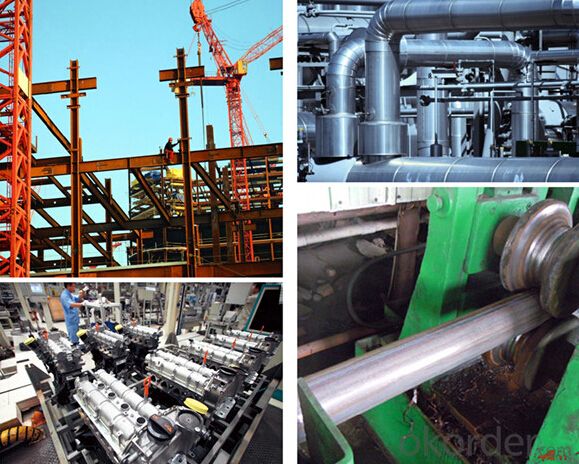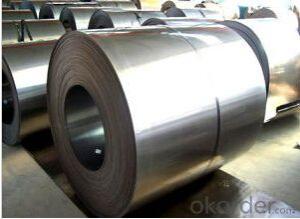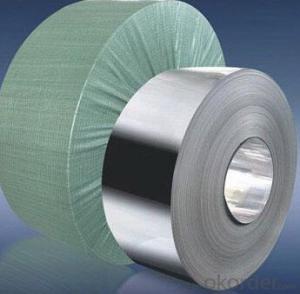Galvanized Rolled Steel Coils Competive Price
- Loading Port:
- Tianjin
- Payment Terms:
- TT OR LC
- Min Order Qty:
- 30 m.t.
- Supply Capability:
- 10000 m.t./month
OKorder Service Pledge
OKorder Financial Service
You Might Also Like
Description:
Surface Treatment:Coated
Technique:Cold Rolled
Standard:ASTM, JIS, GB, AISI, DIN, BS
Steel Grade:Q195
Width:914, 1000, 1200, 1219, 1220, 1250
Export Markets:Global
Additional Info.
Trademark:STW
Packing:Sea Worthy Packing
Standard:0.2mm to 1.2mm
Origin:China
Production Capacity:10000 Tons Per Month
Product Description
Fit for world's standard (ASTM, JIS, EN)
Yeild strength: 235mpa to 550mpa
Width: From 600mm to 1250mm
Thickness: From 0.2mm to 1.2mm
Coating: AZ50, AZ100, AZ150
Other requirements fit for customer's demands


FAQ
1.What's your MOQ?
25MT, it is for one container.
2.Do you have QC teams?
Yeah, sure, our QC team is very important, they will keep the quality control for our products.
3. What's your normal delivery time?
Our delivery time about 10-20days for standard sizes, if you have other requirements like hardness and width ,it is about 20-40days. But don't worry ,we also try our best for the delivery time ,because time longer and our cost is higher.
4.Are the products tested before shipping?
Yes, all of our PPGI and GI was qualified before shipping. We test every batch every day.
- Q:describe the benifits and disadvantages of the using steel as a material for fasteners
- There are different grades of steels which can suit different application considering corrosion,surrounding atmosphere,pressure,temperature and many more. Let us take the stainless steel fasteners: 1.Resists Rust: The primary advantage to using stainless steel bolts is that they resist rusting. This makes them ideal for outdoor or marine uses, since moisture will not cause them to corrode. Rust basically eats steel and makes it weaker. A rusty, weak bolt can be a serious safety risk, because it can break under a load. 2.Clean: Stainless steel bolts are very easy to clean due to having a higher content of chromium, which creates a lustrous, mirror-like surface that is very smooth. This makes stainless steel an ideal option if aesthetics are an issue. 3.Temperature: Stainless steel has a high melting point, which makes it a good option in machines that are put through immense amounts of heat. The bolts will not fuse together, and can be unfastened when the machines need repairs. Also, in very cold conditions, steel can become brittle. By mixing nickel into the stainless steel, the metal resists becoming brittle at low temperatures. See the source link for details.
- Q:They are showing on tv a special on how the new World Trade Center, building 1, is being built. Focusing on the steel and the guys fitting everything together.Where do builders go to buy all that steel framing? We do not build really tall buildings where I live so most of the steel is cut and welded on the job site. At World Trade Center 1, they seem to get the steel on trucks; already cut and welded.
- Most of the parts are cut, welded, and fabricated indoors in a welding shop at another location. Then they're trucked to the site and simply need to be bolted together. This is made possible through the use of computer aided design and modeling programs, so that parts can be made to fit almost presciently in the field. They buy the steel from steel companies. I couldn't tell you exactly where it comes from, you'd have to ask the contractors themselves.
- Q:I know there is soft steel and sturdier steel they use in products. The sturdier often used for equipment that requires more durability when in operation.
- It kind of depends on the application. It can be anywhere from simple to very difficult depending on what exactly you are talking about. Hardening a small piece of carbon tool steel for a chisel or punch consists of simply heating it till its red hot and then quenching it in water. This is done after the tool is formed. Hardening also means making the steel brittle, so it must be tempered after hardening to make it hard and strong. Hardening large or huge pieces like that used for equipment is done at the foundry, where they have equipment to do such a job.
- Q:What is the role of steel coils in the automotive industry?
- Steel coils play a crucial role in the automotive industry as they are the primary raw material used for manufacturing various components and parts of vehicles. These coils are typically made from high-quality steel and are formed into a continuous strip, which can be easily processed and shaped into desired automobile parts. One of the key applications of steel coils in the automotive industry is in the production of body panels and frames. These coils are processed through stamping and forming techniques to create panels such as doors, hoods, fenders, and roofs. Steel coils provide the necessary strength, durability, and rigidity required to withstand external forces and protect the passengers and other components of the vehicle. Moreover, steel coils are also utilized in the manufacturing of various structural components of automobiles. Chassis, suspension systems, and other critical parts such as engine cradles and brackets are typically produced using steel coils due to their excellent mechanical properties. Steel coils possess high tensile strength, which enhances the overall structural integrity of the vehicle and ensures safety. Additionally, steel coils are integral in the production of automotive springs, which play a vital role in the suspension system. Coil springs, leaf springs, and torsion bars are commonly utilized in vehicles to absorb shocks, provide stability, and maintain proper ride height. The use of steel coils in these applications ensures optimal performance, durability, and longevity of the suspension system. In summary, steel coils are essential in the automotive industry for their versatility, strength, and durability. They are used in the manufacturing of body panels, frames, structural components, and suspension systems. The utilization of steel coils in these applications contributes to the overall safety, reliability, and performance of vehicles.
- Q:I want to buy a chain that will last a long time and that i can wear ALL the time.What are the disadvantages to stainless steel jewelry?Does it look as good as silver?Is there much diference in apperance?
- All of I know are stainless steel advantages. it won't stain, corrode, or rust easily. And it keeps its good-looking shine even for many years.
- Q:How are steel coils used in the production of metal partitions?
- Steel coils are used in the production of metal partitions by being processed and cut into sheets, which are then formed and welded together to create the partitions. The steel coils provide a strong and durable material that can withstand the rigors of partition construction and installation.
- Q:What are the different coil packaging options available for steel coils?
- There are several different coil packaging options available for steel coils, depending on the specific requirements and preferences of the customers. Some of the commonly used packaging options include: 1. Steel Strapping: This is a traditional method of packaging steel coils, where a high-tensile steel strap is used to secure the coil. It provides excellent stability and protection during transportation and storage. 2. Plastic Strapping: Plastic strapping is a more cost-effective and lightweight alternative to steel strapping. It is commonly used for smaller and lighter steel coils, providing adequate strength and protection. 3. Shrink Wrapping: Shrink wrapping involves covering the steel coil with a plastic film and then applying heat to shrink and tightly seal the film around the coil. This packaging method offers protection against moisture, dust, and other contaminants. 4. Wooden Crates: Steel coils can also be packaged in wooden crates, which provide additional protection against physical damage during handling and transportation. Wooden crates can be customized to fit the specific dimensions of the coil and can be easily secured with straps or nails. 5. Coil Covers: Coil covers are large, heavy-duty plastic or fabric covers that are placed over the steel coil to protect it from environmental factors such as UV exposure, moisture, and dust. They are often used in combination with other packaging methods for added protection. 6. Paper or Fiberboard Wrapping: This packaging option involves wrapping the steel coil with paper or fiberboard material. It provides a lightweight and cost-effective solution for protecting the coil against minor scratches and abrasions. 7. Customized Packaging: Depending on the specific requirements of the customer, steel coils can be packaged using a combination of the above options or customized packaging solutions. This may include additional padding, corner protectors, or special handling instructions to ensure the safe transportation and storage of the coils. It is important for customers to consider factors such as coil size, weight, transportation mode, storage conditions, and budget when choosing the most suitable coil packaging option for their specific needs.
- Q:How are steel coils used in the manufacturing of agricultural implements?
- Steel coils are used in the manufacturing of agricultural implements by being shaped and formed into various components such as blades, tines, and frames. These components are then assembled or attached to the implements, such as plows, harrows, and cultivators, to enhance their durability, strength, and performance in agricultural activities.
- Q:Can steel coils be coated with barcodes?
- Yes, steel coils can be coated with barcodes. The barcode can be applied to the surface of the steel coil using various methods such as printing, engraving, or even attaching a barcode label. This allows for easy identification and tracking of the steel coils throughout the supply chain.
- Q:i am looking for an exact process of how to forge damascus steel.any tips or pointers and web sites or tutoreals will be helpfull.
- hand made folding knife English tip, blade of Damascus metallic sort Rose, 2,5mm thickness, no liners, teja spring embellished by using metallic report and billet surrounded of chrome metallic. A Damascus blade knife is characterised by using a wavy, mottled visual allure on the blade that’s led to by using the approach used to shape the metallic. the technique of transforming into Damascus metallic is derived from a centuries-previous forging technique used to create blades that grew to become very just about mythical of their attractiveness for power and sharpness it exchange into reported a Damascus knife ought to shrink with the aid of a rifle barrel to boot as with the aid of a hair falling on the blade.
1. Manufacturer Overview |
|
|---|---|
| Location | |
| Year Established | |
| Annual Output Value | |
| Main Markets | |
| Company Certifications | |
2. Manufacturer Certificates |
|
|---|---|
| a) Certification Name | |
| Range | |
| Reference | |
| Validity Period | |
3. Manufacturer Capability |
|
|---|---|
| a)Trade Capacity | |
| Nearest Port | |
| Export Percentage | |
| No.of Employees in Trade Department | |
| Language Spoken: | |
| b)Factory Information | |
| Factory Size: | |
| No. of Production Lines | |
| Contract Manufacturing | |
| Product Price Range | |
Send your message to us
Galvanized Rolled Steel Coils Competive Price
- Loading Port:
- Tianjin
- Payment Terms:
- TT OR LC
- Min Order Qty:
- 30 m.t.
- Supply Capability:
- 10000 m.t./month
OKorder Service Pledge
OKorder Financial Service
Similar products
New products
Hot products
Hot Searches
Related keywords




























